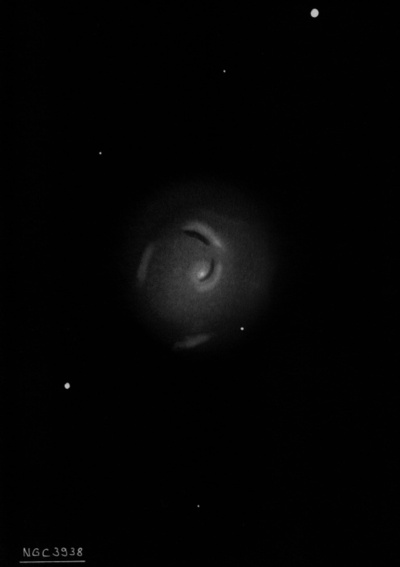
William Herschel discovered NGC 3938 = H I-203 = h1002 on 6 Feb 1788 (sweep 810) and recorded "cB, cL, R pBNM." JH made two observations, logging on sweep 248 "a superb nebula; B; vL; R; 3' diam; vgbM; r; is probably a globular cluster."
On 17 Mar 1849, Johnstone Stoney logged that he "Suspect it to be a spiral. Lord Rosse and I independently thought at moments that were saw a ring around the nucleus. Two years later, Bindon Stoney wrote "Spiral of the faintest class. The middle is pB, but branches vF. Conjectured form as in diagram [which shows a 3-armed spiral]." Listed as "Spiral or curvilinear" in LdR's 1850 PT paper.
400/500mm - 17.5" (4/6/91): fairly bright, fairly large, large round halo, 3'x3', fairly weak concentration, core appears elongated E-W, faint stellar nucleus embedded. This galaxy, along with NGC 4051 and NGC 4111, are the brightest members of the NGC 4111 group (LGG 269) in the UMa Cloud.
900/1200mm - 48" (5/10/18): at 375x; I was very impressed with this gorgeous face-on spiral! Very bright, roundish, over 4' diameter, strongly concentrated with a well defined, very bright round core and bright stellar nucleus. Three principal spiral arms were easily visible. A thin inner arm can be traced 180°; it originates just south of the core and curls counterclockwise towards the west. It dims out as it extends north along the west side [~0.6' from center] but brightens noticeably as it spirals out and detaches from the central region on the northwest side, ending nearly due north [1.3' from center]. A shorter outer arm on the west side was easily visible [at a radius of 1.5'], curving 90° from the southwest to the northwest. These two western arms are separated by a darker interarm gap
The eastern arms have a noticeably lower contrast. The inner eastern arm can be traced with the help of a wide, darker dust lane immediately to its east. The arm disappears into the halo on the south side but just further west two small HII knots, ~6" diameter each, were visible. The knots are separated by 20" E-W, and isolated on the southwest edge of the halo. The 1983 Hodge-Kennicutt "Atlas of HII regions in 125 galaxies" includes multiple designations including #120 [1.4' SSW of center] and #140 [1.5' SW of center]. A 15th magnitude star is ~1' W, just beyond the halo on the SW end.
The outer arm on the eastern edge of the halo could mostly be traced by three HII knots within the arm. The largest is an easily visible 12"-15" patch (#23) on the NE edge of the halo [2.2' from center]. Also 2' ENE of center are a pair of faint knots only ~5" diameter. These are separated by 12" in a N-S orientation, with the northern knot (#3) slightly brighter than the southern (#4).
Notes by Steve Gottlieb